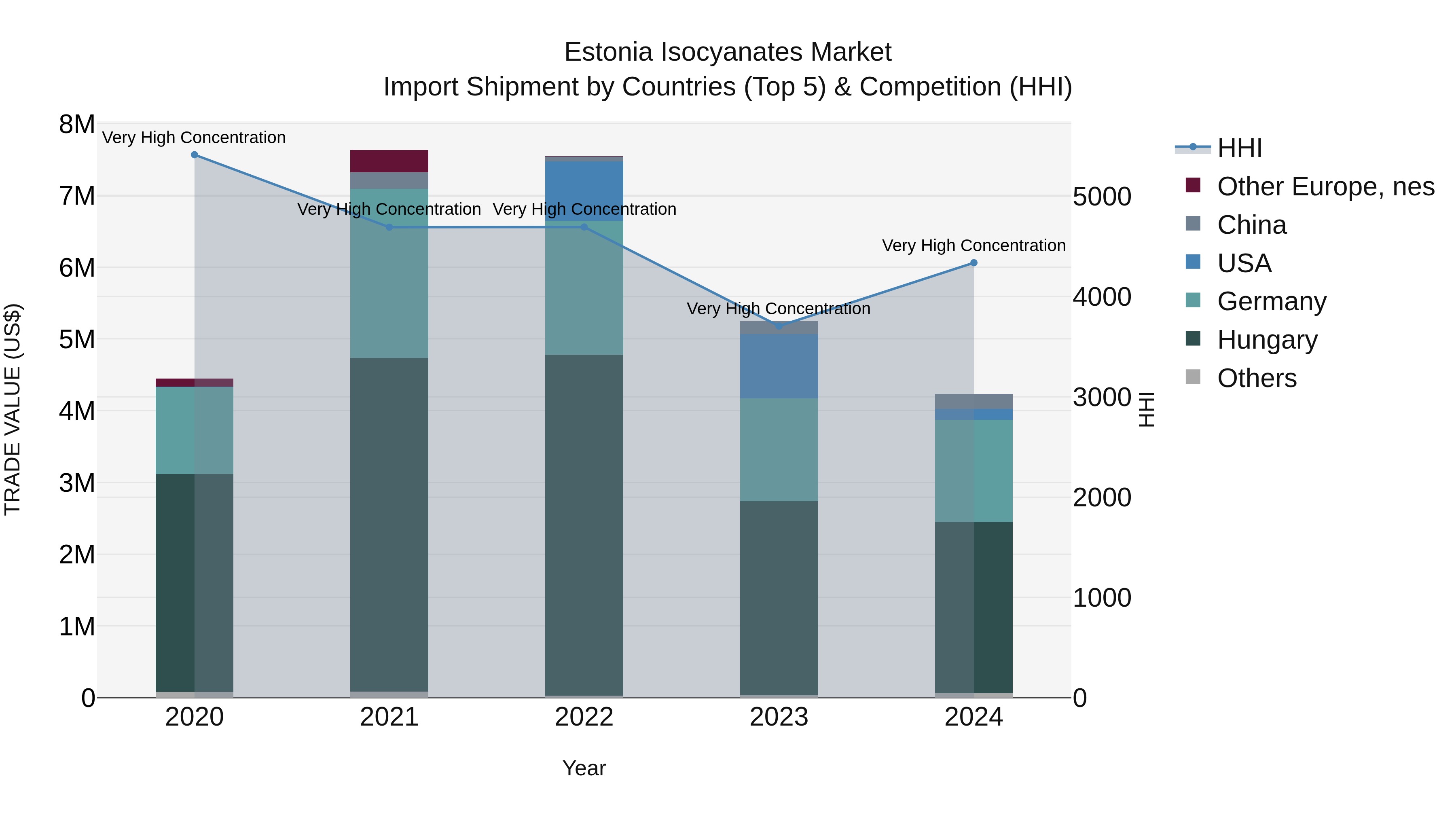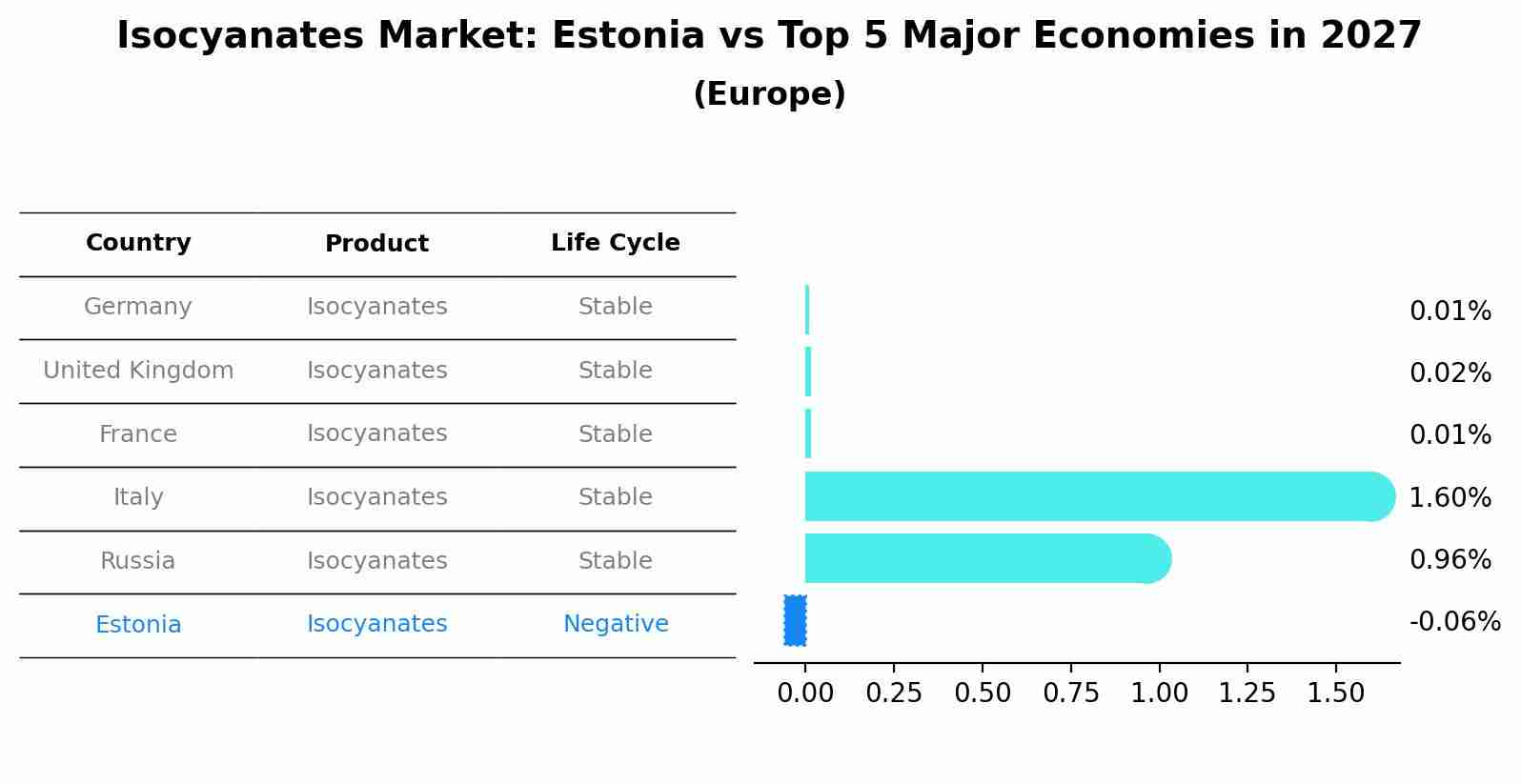Estonia Isocyanates Market (2025-2031) | Share, Industry, Analysis, Companies, Outlook, Size, Growth, Forecast, Value, Segmentation, Trends & Revenue
| Product Code: ETC4820883 | Publication Date: Nov 2023 | Updated Date: Nov 2025 | Product Type: Market Research Report | |
| Publisher: 6Wresearch | Author: Sachin Kumar Rai | No. of Pages: 60 | No. of Figures: 30 | No. of Tables: 5 |
Estonia Isocyanates Market Top 5 Importing Countries and Market Competition (HHI) Analysis
In 2024, Estonia continued to rely heavily on imports of isocyanates, with the top exporting countries being Hungary, Germany, China, USA, and Poland. Despite a negative Compound Annual Growth Rate (CAGR) of -1.23% from 2020 to 2024 and a significant decline in growth rate from 2023 to 2024 at -19.36%, the Herfindahl-Hirschman Index (HHI) indicated a sustained high level of market concentration. This suggests that the isocyanates market in Estonia remains highly competitive, with a few key players dominating the import landscape.

Isocyanates Market: Estonia vs Top 5 Major Economies in 2027 (Europe)
The Isocyanates market in Estonia is projected to grow at a negative growth rate of -0.06% by 2027, highlighting the country's increasing focus on advanced technologies within the Europe region, where Germany holds the dominant position, followed closely by United Kingdom, France, Italy and Russia, shaping overall regional demand.

Estonia Isocyanates Market Overview
The isocyanates market in Estonia is driven by the growing use of polyurethane-based materials in construction, automotive, and furniture manufacturing. As industries demand more durable, efficient, and environmentally friendly materials, the market for isocyanates is expected to expand. With a strong focus on sustainability, Estonia is witnessing an increased demand for isocyanates used in high-performance coatings and adhesives that offer better durability and environmental benefits.
Drivers of the market
The isocyanate market in Estonia is driven by its applications in polyurethane production, essential for insulation materials and coatings. The construction industry`s growth and increasing energy efficiency regulations contribute to market expansion.
Challenges of the market
The isocyanate market is heavily regulated due to the toxic nature of isocyanates, which require stringent handling protocols to protect worker health and safety. Compliance with these regulations can increase production costs and complexity. Additionally, the market faces growing pressure from sustainability advocates to find greener alternatives to isocyanates, especially given their widespread use in the production of polyurethane foams and coatings. Competition from bio-based substitutes, which are perceived as safer and more environmentally friendly, is also intensifying. Another challenge is the fluctuation in the price of raw materials, which can affect the overall cost structure of isocyanate products.
Government Policy of the market
Estonian policies in the isocyanate market support the use of isocyanates in the production of polyurethane foams, coatings, and adhesives, with a focus on industrial applications. The government promotes research into safer isocyanate alternatives while ensuring compliance with EU health and environmental regulations, particularly those related to chemical safety.
Key Highlights of the Report:
- Estonia Isocyanates Market Outlook
- Market Size of Estonia Isocyanates Market, 2024
- Forecast of Estonia Isocyanates Market, 2031
- Historical Data and Forecast of Estonia Isocyanates Revenues & Volume for the Period 2021-2031
- Estonia Isocyanates Market Trend Evolution
- Estonia Isocyanates Market Drivers and Challenges
- Estonia Isocyanates Price Trends
- Estonia Isocyanates Porter`s Five Forces
- Estonia Isocyanates Industry Life Cycle
- Historical Data and Forecast of Estonia Isocyanates Market Revenues & Volume By Type for the Period 2021-2031
- Historical Data and Forecast of Estonia Isocyanates Market Revenues & Volume By MDI for the Period 2021-2031
- Historical Data and Forecast of Estonia Isocyanates Market Revenues & Volume By TDI for the Period 2021-2031
- Historical Data and Forecast of Estonia Isocyanates Market Revenues & Volume By Aliphatic and Cycloaliphatic for the Period 2021-2031
- Historical Data and Forecast of Estonia Isocyanates Market Revenues & Volume By Application for the Period 2021-2031
- Historical Data and Forecast of Estonia Isocyanates Market Revenues & Volume By Elastomers for the Period 2021-2031
- Historical Data and Forecast of Estonia Isocyanates Market Revenues & Volume By Elastomers for the Period 2021-2031
- Historical Data and Forecast of Estonia Isocyanates Market Revenues & Volume By Binders for the Period 2021-2031
- Historical Data and Forecast of Estonia Isocyanates Market Revenues & Volume By End-use for the Period 2021-2031
- Historical Data and Forecast of Estonia Isocyanates Market Revenues & Volume By Automotive for the Period 2021-2031
- Historical Data and Forecast of Estonia Isocyanates Market Revenues & Volume By Building & Construction for the Period 2021-2031
- Historical Data and Forecast of Estonia Isocyanates Market Revenues & Volume By Electronics for the Period 2021-2031
- Historical Data and Forecast of Estonia Isocyanates Market Revenues & Volume By Others for the Period 2021-2031
- Estonia Isocyanates Import Export Trade Statistics
- Market Opportunity Assessment By Type
- Market Opportunity Assessment By Application
- Market Opportunity Assessment By End-use
- Estonia Isocyanates Top Companies Market Share
- Estonia Isocyanates Competitive Benchmarking By Technical and Operational Parameters
- Estonia Isocyanates Company Profiles
- Estonia Isocyanates Key Strategic Recommendations
Frequently Asked Questions About the Market Study (FAQs):
1 Executive Summary |
2 Introduction |
2.1 Key Highlights of the Report |
2.2 Report Description |
2.3 Market Scope & Segmentation |
2.4 Research Methodology |
2.5 Assumptions |
3 Estonia Isocyanates Market Overview |
3.1 Estonia Country Macro Economic Indicators |
3.2 Estonia Isocyanates Market Revenues & Volume, 2021 & 2031F |
3.3 Estonia Isocyanates Market - Industry Life Cycle |
3.4 Estonia Isocyanates Market - Porter's Five Forces |
3.5 Estonia Isocyanates Market Revenues & Volume Share, By Type, 2021 & 2031F |
3.6 Estonia Isocyanates Market Revenues & Volume Share, By Application, 2021 & 2031F |
3.7 Estonia Isocyanates Market Revenues & Volume Share, By End-use, 2021 & 2031F |
4 Estonia Isocyanates Market Dynamics |
4.1 Impact Analysis |
4.2 Market Drivers |
4.3 Market Restraints |
5 Estonia Isocyanates Market Trends |
6 Estonia Isocyanates Market Segmentations |
6.1 Estonia Isocyanates Market, By Type |
6.1.1 Overview and Analysis |
6.1.2 Estonia Isocyanates Market Revenues & Volume, By MDI, 2021-2031F |
6.1.3 Estonia Isocyanates Market Revenues & Volume, By TDI, 2021-2031F |
6.1.4 Estonia Isocyanates Market Revenues & Volume, By Aliphatic and Cycloaliphatic, 2021-2031F |
6.2 Estonia Isocyanates Market, By Application |
6.2.1 Overview and Analysis |
6.2.2 Estonia Isocyanates Market Revenues & Volume, By Elastomers, 2021-2031F |
6.2.3 Estonia Isocyanates Market Revenues & Volume, By Elastomers, 2021-2031F |
6.2.4 Estonia Isocyanates Market Revenues & Volume, By Binders, 2021-2031F |
6.3 Estonia Isocyanates Market, By End-use |
6.3.1 Overview and Analysis |
6.3.2 Estonia Isocyanates Market Revenues & Volume, By Automotive, 2021-2031F |
6.3.3 Estonia Isocyanates Market Revenues & Volume, By Building & Construction, 2021-2031F |
6.3.4 Estonia Isocyanates Market Revenues & Volume, By Electronics, 2021-2031F |
6.3.5 Estonia Isocyanates Market Revenues & Volume, By Others, 2021-2031F |
7 Estonia Isocyanates Market Import-Export Trade Statistics |
7.1 Estonia Isocyanates Market Export to Major Countries |
7.2 Estonia Isocyanates Market Imports from Major Countries |
8 Estonia Isocyanates Market Key Performance Indicators |
9 Estonia Isocyanates Market - Opportunity Assessment |
9.1 Estonia Isocyanates Market Opportunity Assessment, By Type, 2021 & 2031F |
9.2 Estonia Isocyanates Market Opportunity Assessment, By Application, 2021 & 2031F |
9.3 Estonia Isocyanates Market Opportunity Assessment, By End-use, 2021 & 2031F |
10 Estonia Isocyanates Market - Competitive Landscape |
10.1 Estonia Isocyanates Market Revenue Share, By Companies, 2024 |
10.2 Estonia Isocyanates Market Competitive Benchmarking, By Operating and Technical Parameters |
11 Company Profiles |
12 Recommendations | 13 Disclaimer |
- Single User License$ 1,995
- Department License$ 2,400
- Site License$ 3,120
- Global License$ 3,795
Search
Thought Leadership and Analyst Meet
Our Clients
Related Reports
- Canada Oil and Gas Market (2026-2032) | Share, Segmentation, Value, Industry, Trends, Forecast, Analysis, Size & Revenue, Growth, Competitive Landscape, Outlook, Companies
- Germany Breakfast Food Market (2026-2032) | Industry, Share, Growth, Size, Companies, Value, Analysis, Revenue, Trends, Forecast & Outlook
- Australia Briquette Market (2025-2031) | Growth, Size, Revenue, Forecast, Analysis, Trends, Value, Share, Industry & Companies
- Vietnam System Integrator Market (2025-2031) | Size, Companies, Analysis, Industry, Value, Forecast, Growth, Trends, Revenue & Share
- ASEAN and Thailand Brain Health Supplements Market (2025-2031) | Strategy, Consumer Insights, Analysis, Investment Trends, Opportunities, Growth, Size, Share, Industry, Revenue, Segments, Value, Segmentation, Supply, Forecast, Restraints, Outlook, Competition, Drivers, Trends, Demand, Pricing Analysis, Competitive, Strategic Insights, Companies, Challenges
- ASEAN Bearings Market (2025-2031) | Strategy, Consumer Insights, Analysis, Investment Trends, Opportunities, Growth, Size, Share, Industry, Revenue, Segments, Value, Segmentation, Supply, Forecast, Restraints, Outlook, Competition, Drivers, Trends, Demand, Pricing Analysis, Competitive, Strategic Insights, Companies, Challenges
- Europe Flooring Market (2025-2031) | Outlook, Share, Industry, Trends, Forecast, Companies, Revenue, Size, Analysis, Growth & Value
- Saudi Arabia Manlift Market (2025-2031) | Outlook, Size, Growth, Trends, Companies, Industry, Revenue, Value, Share, Forecast & Analysis
- Uganda Excavator, Crane, and Wheel Loaders Market (2025-2031) | Strategy, Consumer Insights, Analysis, Investment Trends, Opportunities, Growth, Size, Share, Industry, Revenue, Segments, Value, Segmentation, Supply, Forecast, Restraints, Outlook, Competition, Drivers, Trends, Demand, Pricing Analysis, Competitive, Strategic Insights, Companies, Challenges
- Rwanda Excavator, Crane, and Wheel Loaders Market (2025-2031) | Strategy, Consumer Insights, Analysis, Investment Trends, Opportunities, Growth, Size, Share, Industry, Revenue, Segments, Value, Segmentation, Supply, Forecast, Restraints, Outlook, Competition, Drivers, Trends, Demand, Pricing Analysis, Competitive, Strategic Insights, Companies, Challenges
Industry Events and Analyst Meet
Whitepaper
- Middle East & Africa Commercial Security Market Click here to view more.
- Middle East & Africa Fire Safety Systems & Equipment Market Click here to view more.
- GCC Drone Market Click here to view more.
- Middle East Lighting Fixture Market Click here to view more.
- GCC Physical & Perimeter Security Market Click here to view more.
6WResearch In News
- Doha a strategic location for EV manufacturing hub: IPA Qatar
- Demand for luxury TVs surging in the GCC, says Samsung
- Empowering Growth: The Thriving Journey of Bangladesh’s Cable Industry
- Demand for luxury TVs surging in the GCC, says Samsung
- Video call with a traditional healer? Once unthinkable, it’s now common in South Africa
- Intelligent Buildings To Smooth GCC’s Path To Net Zero


















